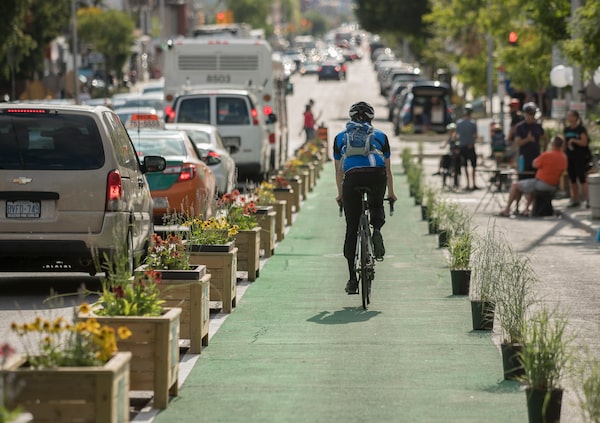
A cyclist rides down a bike lane normally occupied by traffic on Danforth Avenue during a pop-up street makeover in Toronto, on Aug. 23, 2019.J.P. MOCZULSKI
In the 1970s, when architect Arthur Erickson designed the Law Courts building in Vancouver, he envisioned a grand plaza between the new courthouse and the old one across Robson Street, now the Vancouver Art Gallery. What Mr. Erickson had in mind was the city’s largest public square, right in the heart of downtown.
That didn’t happen. Once construction was complete, Robson Street was returned to its presumed owner: the car.
That story has played out over and over again across Canada. Our cities have been built, and our downtowns rebuilt, for cars. Assuming their primacy has been the first commandment of city planning and city politics. Any deviation from the gospel ignites debate conducted at the intensity of a constitutional amendment.
But the past decade has seen sprouts of change break through the dense pavement of our civic mentality. Vancouver, for example, eventually figured out that Mr. Erickson was right. After Robson Street was temporarily closed to cars and turned into a pedestrian plaza during the 2010 Winter Olympics, the city, after much debate, made the arrangement permanent.
In New York, an extended stretch of Broadway was overhauled a decade ago, narrowing the space for cars and increasing it for bikes and people. Times Square, the most famous city block in the United States, was transformed from a constant snarl of traffic into a pedestrian mecca. Paris went car-free along part of the Right Bank of the Seine. San Francisco this year closed part of Market Street.
The novel coronavirus pandemic is forcing a rethink of how cities are built and how we live in them. A large part of that rethink has been about the balance between cars and everything else.
City politicians are suddenly willing to consider whether the enormous amount of space devoted to cars could perhaps be ever so slightly reduced and repurposed for cyclists and pedestrians. Things long politically impossible are actually happening.
This week, Toronto City Council will consider a plan to add 25 kilometres of bike paths, including extending the short cycling route along Bloor Street far to the west and east, and carving a bike path out of University Avenue’s eight car lanes.
These changes are necessary, they should be permanent – and they also should be a starting point for a new kind of city building that leaves behind cars-first thinking.
Toronto’s government was resistant to any such changes in the first months of the pandemic. City council is dominated by suburban representatives and, until now, any notion of making even one downtown street so much as slightly less car-centric would be attacked as, in the late mayor Rob Ford’s phrase, the “war on the car.”
But COVID-19 may have changed the equation. Toronto didn’t close any downtown streets to cars, as many residents wanted, but during the past two weekends, it turned long stretches of Bayview Avenue and Lake Shore Boulevard into areas reserved for human-powered traffic.
Both moves were immediate successes; empty roadways were filled with crowds of joggers and cyclists.
Wedged into the space between High Park and Lake Ontario, there are three major roads, including Lake Shore Boulevard, with up to 18 lanes of car traffic. The closings leave 13 to 14 lanes for cars. It’s hard to see why this should not become a permanent feature, at the very least on weekends from May to October.
Vancouver, likewise, should make its pandemic-inspired partial closing of Beach Avenue permanent and limit cars in Stanley Park.
It’s time to get more ambitious. In Toronto and in all Canadian cities, there are so many opportunities to turn over space to people, from wider sidewalks, to more bike lanes, to space on city roads for restaurant patios.
City life is about more than just moving quickly from A to B. Cities are at their best when their design creates moments of pleasure, not in passing through somewhere, but in being there, on foot, on any random street. Cities are where people come together. When we’re alone in our cars, we wall ourselves off from each other. In a public plaza, such as the one Vancouver finally got, it’s the opposite.
A health emergency has freed Canadians to reconsider important things about how we live. Once the emergency has passed, we should remember the lessons learned.